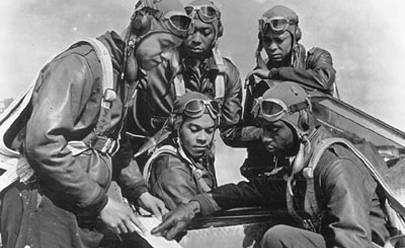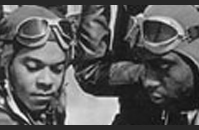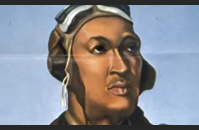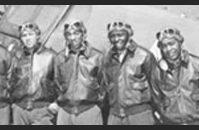THE TUSKEGEE AIRMEN AT A GLANCE:

Image Gallery
The Tuskegee Airmen: The African American Pilots of WWII
Before the Tuskegee Airmen, no African American had ever been a United States military pilot. The Jim Crow laws, a series of racist laws that enforced the “separate but equal” treatment of African Americans, were used as justification for blocking previous attempts by African American soldiers to become pilots. African Americans served bravely and with distinction in every theater of World War II, while simultaneously struggling for their own civil rights from “the world’s greatest democracy.” Although the United States Armed Forces were officially segregated until 1948, WWII laid the foundation for post-war integration of the military. In 1941 fewer than 4,000 African Americans were serving in the military and only twelve African Americans had become officers. By 1945, more than 1.2 million African Americans would be serving in uniform on the Home Front, in Europe, and the Pacific (including thousands of African American women in the Women’s auxiliaries).
The Army Air Forces established several African American organizations, including fighter and bombardment groups and squadrons. Between 1941 and 1946, roughly 1,000 black pilots were trained at a segregated air base in Tuskegee, AL. The Tuskegee Airmen flew hundreds of patrol and attack missions for the Twelfth Air Force, flying P-40 and P-39 airplanes, before they were reassigned to the 15th Air Force to escort B-17 and B-24 heavy bombers, using P-47 and P-51 airplanes. The famous “Tuskegee Airmen” of the 332nd Fighter Group became part of the 15th Air Force, escorting American bombers as they flew over Italy. As escorts, flying P-47s and later P-51s, they were responsible for protecting larger bombers from German fighter planes. The Tuskegee Airmen flew more than 15,000 sorties between May 1943 and June 1945. Bomber crews often requested to be escorted by these “Red Tails,” a nicknamed acquired from the painted tails of Tuskegee fighter planes, which were a distinctive deep red. Sixty-six Tuskegee Airmen died in combat. They had one of the lowest loss records of any escort fighter group.
C. Alfred “Chief” Anderson is one of the most famous of the pilots in the Tuskegee Airmen story. In 1929, Anderson had earned his pilot’s license, and went on to become the first African American to earn a commercial pilot’s certification in 1932. In March 1941, Anderson took First Lady Eleanor Roosevelt on a 30-minute flight in a biplane. The flight brought much-needed attention to the Tuskegee Airmen.
The Tuskegee Airmen achieved a number of successes during World War II. The 332nd Fighter Group was awarded the Distinguished Unit Citation for their actions on March 24, 1945. On their way to Berlin, Germany, the Red Tails destroyed three German ME-262’s. In all, the Tuskegee Airmen earned eight Purple Hearts, fourteen Bronze Stars, three Distinguished Unit Citations, and 96 Distinguished Flying Crosses.
The National WWII Museum honors the contributions of the Tuskegee Airmen in World War II.
Download a printable version of this At A Glance
TAKE ACTION:


EDUCATION PROJECTS:
Student Travel – WWII Educational Tours
High school and college students, learn the leadership principles that helped win WWII on a trip to France or during a weeklong residential program in New Orleans. College credit is available, and space is limited.
See You Next Year! HS Yearbooks from WWII
Collected from across the United States, the words and pictures of these yearbooks present a new opportunity to experience the many challenges, setbacks and triumphs of the war through the eyes of America’s youth.
The Victory Gardens of WWII
Visit the Classroom Victory Garden Project website to learn about food production during WWII, find lesson plans and activities for elementary students, get tips for starting your own garden and try out simple Victory Garden recipes!
The Science and Technology of WWII
Visit our new interactive website to learn about wartime technical and scientific advances that forever changed our world. Incorporates STEM principles to use in the classroom.
Kids Corner: Fun and Games!
Make your own propaganda posters, test your memory, solve puzzles and more! Learn about World War II and have fun at the same time.






